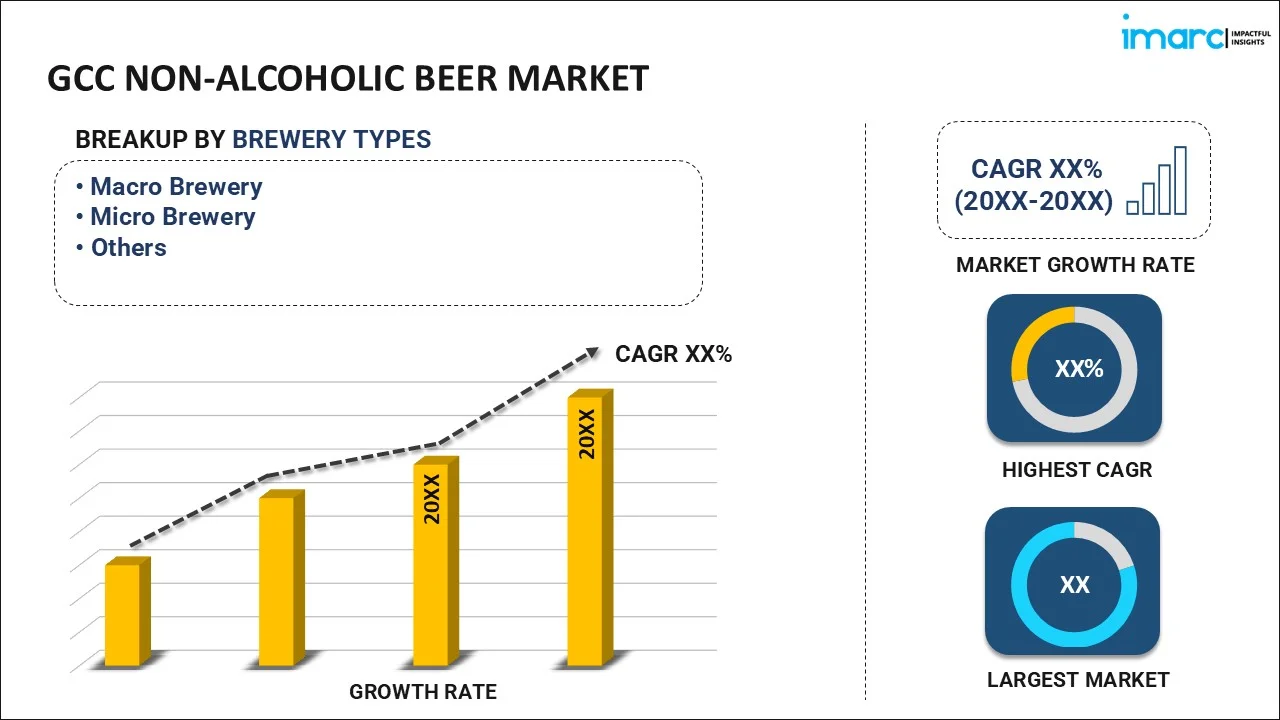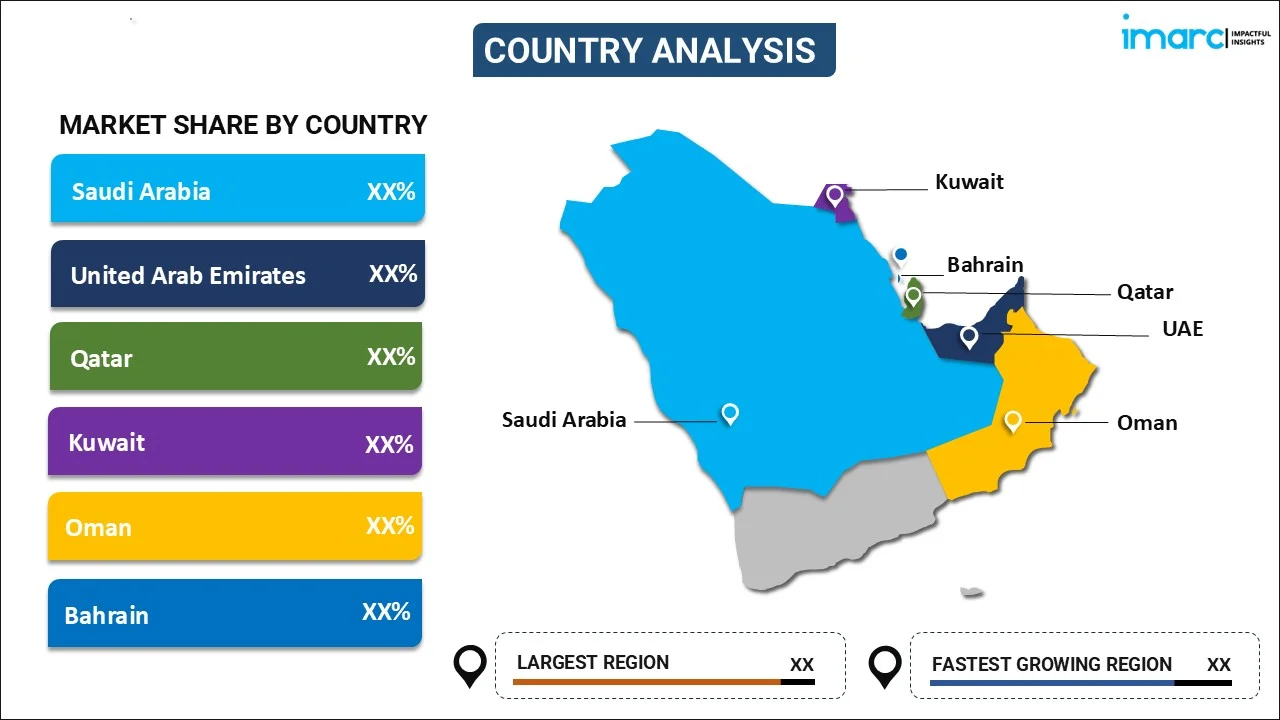
GCC Non-Alcoholic Beer Market Report by Brewery Type (Macro Brewery, Micro Brewery, and Others), Technology (Restricted Fermentation, Dealcoholization, and Others), Flavour (Flavoured, Unflavoured), Packaging (Glass Bottles, Metal Cans, and Others), Distributional Channel (Direct Sales, Supermarkets and Hypermarkets, Convenience Stores, Specialty Stores, Online Retail, and Others), End User (Institutions, Direct Consumers), and Country 2025-2033
Market Overview:
The GCC Non-Alcoholic beer market size reached USD 87.8 Million in 2024. The market is projected to reach USD 137.3 Million by 2033, exhibiting a growth rate (CAGR) of 4.85% during 2025-2033. Increasing health awareness and rising preferences for healthier beverage alternatives are fueling the market growth. Consumers are reducing alcohol intake and seeking low-calorie, refreshing options. Non-alcoholic beer offers the taste of traditional beer without the health risks, making it popular among health-conscious individuals and those following cultural or religious norms.
|
Report Attribute
|
Key Statistics
|
|---|---|
|
Base Year
|
2024
|
|
Forecast Years
|
2025-2033
|
|
Historical Years
|
2019-2024
|
|
Market Size in 2024
|
USD 87.8 Million |
|
Market Forecast in 2033
|
USD 137.3 Million |
| Market Growth Rate 2025-2033 | 4.85% |
Non-alcoholic beer refers to a temperance beverage prepared by the fermentation of various ingredients, such as malt, hop, water, and yeast. Non-alcoholic beer offers numerous benefits in maintaining good heart health, improving liver functioning, minimizing the risk of intoxication, controlling alcohol dependency, etc.
In the GCC countries, the wide presence of the Muslim population, for whom alcohol consumption is non-permissible according to the Islam Sariah Law, is augmenting the market growth. The increasing popularity of a wide range of flavors of non-alcoholic beer, particularly among the millennial and women population, is also propelling the market growth across the region. Additionally, improving consumer living standards supported by their rising income levels have increased the per capita expenditures on high-quality and premium non-alcoholic beverages. In line with this, with the changing consumer tastes and preferences, various regional manufacturers are introducing innovative flavors and textures of non-alcoholic beer. Moreover, several international market players are introducing malted beverages into their product categories to cater to the traditional culture and beliefs of the consumers in the region. In the coming years, the rising availability of non-alcoholic beer across several brick-and-mortar and online retail stores will continue to further drive the market growth in the GCC region.
GCC Non-Alcoholic Beer Market Trends:
Growing demand for functional beverages
Rising demand for functional beverages is positively influencing the market in the GCC region. As per the IMARC Group, the Saudi Arabia functional beverages market size reached USD 1,331.82 Million in 2024. Non-alcoholic beer is being infused with added vitamins, electrolytes, antioxidants, and low-sugar formulations, making it appealing to those looking for healthier alternatives to soft drinks or traditional beer. These enhanced beverages are particularly attractive to individuals following fitness regimes, dietary restrictions, and recovery routines. As wellness trends are growing, people are shifting towards products that combine enjoyment with health benefits, and non-alcoholic beer fits this demand by offering hydration, low calories, and a refreshing taste. Functional ingredients also allow brands to position their items for niche markets, such as athletes, professionals, and older consumers.
Broadening of retail outlets
The expansion of retail outlets is significantly contributing to the growth of the market by improving product availability and user access. Supermarkets, hypermarkets, and convenience stores are stocking a variety of non-alcoholic beer brands, offering people a wider selection in terms of flavor, price, and origin. Organized retail also provides structured shelf displays, in-store promotions, and attractive packaging that increase visibility and encourage trial purchases. Additionally, the rise of e-commerce platforms and home delivery services is making non-alcoholic beer more accessible, especially for those who prefer private or convenient buying experiences. Retail growth across urban and suburban areas ensures that non-alcoholic beer reaches diverse customer segments, including expatriates and health-conscious buyers. With more retail touchpoints and marketing support, people are more likely to discover and adopt non-alcoholic beer as a regular part of their beverage choices. This expanding retail ecosystem continues to strengthen the market penetration across the region. As per industry reports, retail sales within the GCC region are projected to attain USD 386.9 Billion by 2028.
Growth in café and casual dining culture
The growth in café and casual dining culture is offering a favorable market outlook. With the rising youth population across the region, the demand for trendy non-alcoholic beer options in cafés and dining spots is rising. According to the 2024 Saudi Family Statistics Report published by the General Authority for Statistics (GASTAT), approximately 71% of Saudi Arabia’s population was below the age of 35 in 2024. Non-alcoholic beer is becoming a popular choice among those looking for a sophisticated, adult-like drink experience without alcohol. Restaurants and cafés include non-alcoholic beer on their menus to cater to modern preferences, especially in urban centers where lifestyle dining is on the rise. These venues often serve non-alcoholic beer with international cuisine or as part of special meal pairings, enhancing the dining experience. As casual dining is becoming more of a social norm, especially among young adults and professionals, the presence of non-alcoholic beer adds variety and appeals to a broader audience. This trend is supporting brand exposure and normalizing consumption in everyday settings.
Key Growth Drivers of GCC Non-Alcoholic Beer Market:
Technological advancements in brewing
Technological advancements in brewing are improving taste, quality, and variety, making the product more appealing to people. Modern brewing methods, such as dealcoholization and advanced fermentation, allow producers to retain the authentic flavor, aroma, and mouthfeel of traditional beer without the alcohol content. These innovations address past concerns about flat taste or watery textures, leading to higher consumer acceptance and repeat purchases across the GCC region. Brands are also experimenting with new ingredients, natural flavors, and formulations to cater to local preferences and dietary standards. Enhanced production techniques allow consistent quality, longer shelf life, and scalable manufacturing, which helps meet rising demand. These improvements not only attract new consumers but also allow existing beer drinkers to enjoy a similar experience without compromising religious or health values.
Increasing focus on innovative packaging and marketing
Brands are investing in modern packaging that mirrors traditional beer aesthetics, helping to appeal to people seeking a sophisticated beverage without alcohol. Eye-catching labels, eco-friendly materials, and convenient formats like cans and multipacks cater to both on-the-go and at-home consumption. Meanwhile, targeted marketing campaigns, especially on digital and social media platforms, emphasize lifestyle, wellness, and cultural fit, aiding in shifting public perception of non-alcoholic beer. Promotions featuring athletes, influencers, and celebrities enhance brand visibility and trust, particularly among younger demographics. These strategies are not only increasing awareness but also normalizing consumption in social settings. As competition is rising, brands are differentiating through storytelling and value-added features, making non-alcoholic beer a compelling choice in a crowded beverage market across the GCC region.
Rising tourism activities
Increasing tourism activities are bolstering the market growth. As the region is attracting more international tourists for business, leisure, and events, hospitality providers are expanding their offerings to suit diverse preferences. Non-alcoholic beer is a popular choice among tourists looking for a refreshing and familiar drink that complies with local regulations. Hotels, resorts, and restaurants often stock a variety of non-alcoholic beer brands to enhance guest satisfaction and meet international standards. Tourism events, festivals, and sporting gatherings further increase exposure and consumption of these beverages. Additionally, travel retail outlets like airport shops and duty-free stores promote non-alcoholic beer as a premium, travel-friendly option. As tourism continues to grow in cities like Dubai, Riyadh, and Doha, so does the demand for inclusive beverage offerings, making non-alcoholic beer a key product benefiting from the region’s thriving hospitality and tourism ecosystem.
Key Market Segmentation:
IMARC Group provides an analysis of the key trends in each segment of the GCC Non-Alcoholic beer market report, along with forecasts at the regional and country levels from 2025-2033. Our report has categorized the market based on brewery type, technology, flavour, packaging, distributional channel and end user.
Breakup by Brewery Type:

To get more information on this market, Request Sample
- Macro Brewery
- Micro Brewery
- Others
Breakup by Technology:
- Restricted Fermentation
- Dealcoholization
- Others
Breakup by Flavour:
- Flavoured
- Unflavoured
Breakup by Packaging:
- Glass Bottles
- Metal Cans
- Others
Breakup by Distributional Channel:
- Direct Sales
- Supermarkets and Hypermarkets
- Convenience Stores
- Specialty Stores
- Online Retail
- Others
Breakup by End User:
- Institutions
- Direct Consumers
Breakup by Country:

- UAE
- Saudi Arabia
- Oman
- Kuwait
- Bahrain
- Qatar
Competitive Landscape:
The competitive landscape of the industry has also been examined with some of the key players being Barbican (Aujan Group Holding), Anheuser-Busch InBev, Carlsberg Breweries A/S (Carlsberg Group), Heineken N.V. (Heineken Holding N.V.), and Swinkels Family Brewers.
GCC Non-Alcoholic Beer Market News:
- February 2025: Midtown Factory, a Dubai company, unveiled halal-brewed Arabian Ale, a type of beer. It included various ingredients typically present in regular beer and had no alcohol during the complete brewing process.
Report Coverage:
| Report Features | Details |
|---|---|
| Base Year of the Analysis | 2024 |
| Historical Period | 2019-2024 |
| Forecast Period | 2025-2033 |
| Units | Million USD |
| Segment Coverage | Brewery Type, Technology, Flavour, Packaging, Distributional Channel, End User, Country |
| Countries Covered | Saudi Arabia, UAE, Oman, Qatar, Kuwait, Bahrain |
| Companies Covered | Barbican (Aujan Group Holding), Anheuser-Busch InBev, Carlsberg Breweries A/S (Carlsberg Group), Heineken N.V. (Heineken Holding N.V.), Swinkels Family Brewers |
| Customization Scope | 10% Free Customization |
| Post-Sale Analyst Support | 10-12 Weeks |
| Delivery Format | PDF and Excel through Email (We can also provide the editable version of the report in PPT/Word format on special request) |
Key Questions Answered in This Report
The non-alcoholic beer market in GCC was valued at USD 87.8 Million in 2024.
The non-alcoholic beer market in GCC is projected to exhibit a CAGR of 4.85% during 2025-2033, reaching a value of USD 137.3 Million by 2033.
GCC non-alcoholic beer market is driven by rising health consciousness, religious and cultural prohibitions on alcohol consumption, and rising demand for lifestyle-driven, low-calorie beverages. Rising tourism and multicultural expatriate population further propel the consumption. Flavour innovations, premium segment products, and aggressive marketing have gained popularity. Growing availability from retail and hospitality platforms, changing social norms, and a youth population of consumers with a trend following mind-set further add to the steady growth of the market.
Some of the major players in the GCC non-alcoholic beer market include Barbican (Aujan Group Holding), Anheuser-Busch InBev, Carlsberg Breweries A/S (Carlsberg Group), Heineken N.V. (Heineken Holding N.V.), Swinkels Family Brewers.
Need more help?
- Speak to our experienced analysts for insights on the current market scenarios.
- Include additional segments and countries to customize the report as per your requirement.
- Gain an unparalleled competitive advantage in your domain by understanding how to utilize the report and positively impacting your operations and revenue.
- For further assistance, please connect with our analysts.
 Request Customization
Request Customization
 Speak to an Analyst
Speak to an Analyst
 Request Brochure
Request Brochure
 Inquire Before Buying
Inquire Before Buying




.webp)




.webp)












